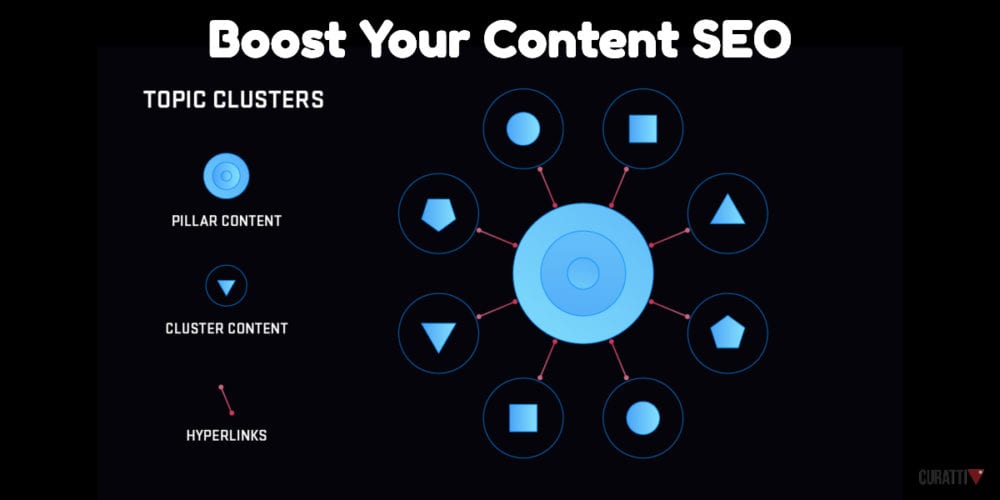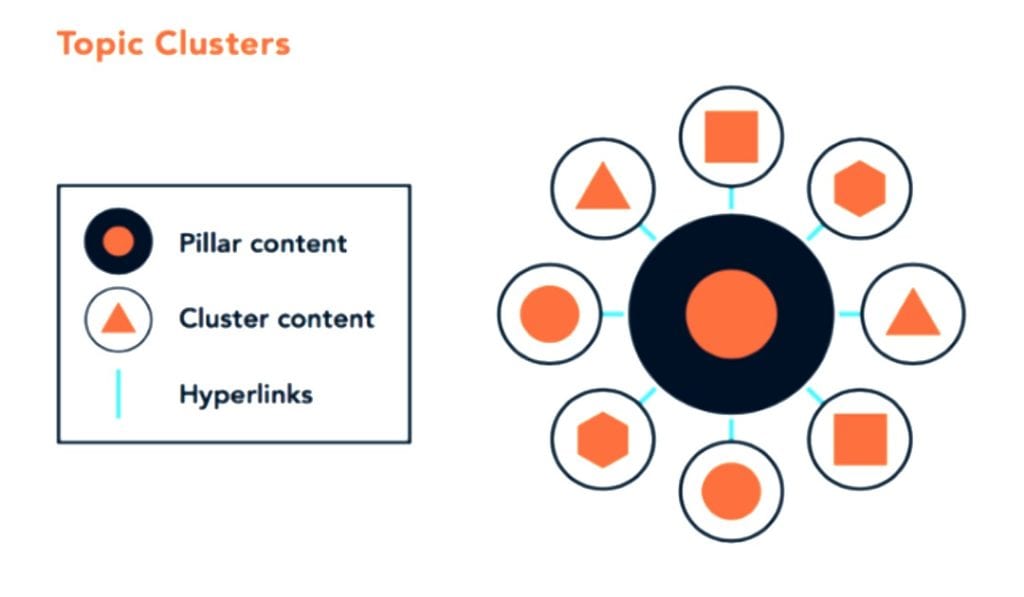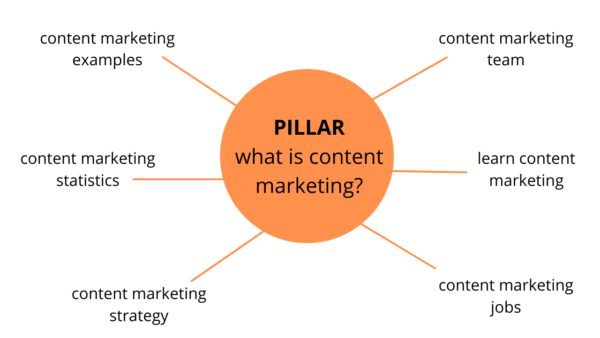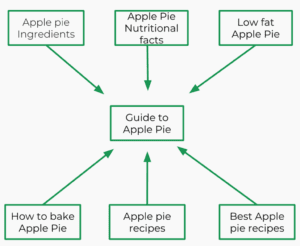Topic Clusters In Content Marketing: Here’s What You Need To Know

You are probably among the millions who are struggling to feature on the high-ranking result pages. Though it looks easy from the outside, it isn’t in real terms. This is because thousands like you (from your niche alone) are fighting the same battle. However, getting slotted within the top positions can be done. You can also create content that Google would fall in love with.
There is a need for building a topic-based content bank that can effectively be used to target your potential customers.
Content Clusters are also known as the “Pillar and Cluster” technique came into practice in the year 2017 powered by HubSpot Research. This methodology has since been utilized by both the B2C and B2B models to achieve more out of their content marketing activities.
Pillar Content
Let’s understand the concept of ‘pillar’ content marketing, its branches of terms, and how it leads to a successful strategy.
- Unlike the general practice of concentrating on KEYWORDS and their usage, Content Clusters concentrate on individual TOPICS.
- Instead of going for multiple keyword targeting processes, this method is intent focused, creating a blog bank of content covering one particular topic. This is also known as the Pillar page or post.
- The use of Content Clusters has increased in the past years as it is an effective method of content marketing that enables stamping the authority of a website on a specific topic that connects the core business niche.
- Increasing numbers of agencies are taking up this mode of building a resourceful content cluster that enhances their core content marketing strategy. There is an availability of a massive content backup that provides a lot of developments within the business niche covering all aspects of the topic as well as the industry.
- This cluster of blog articles and other content formats on the core topic is the easiest way to cover all the important, working keywords as they would be present within the content.
- The basic idea of creating such a content cluster is to achieve maximum content reliability, creating positives on the search engine pages.
What are Topic Clusters and How Do They Work For Better Rankings?
Until now, the content we created tended to revolve around keywords. But, it won’t be enough if you want to bring more traffic into your website and conversions too.
The pillar page and topic cluster concepts would be very helpful here. The concept could bring more traffic to your website and you can see the visible improvement in ranking as well.
When we put something in the Google search bar, the crawlers try to search for the best possible answers to the query you have inserted in it. Topic cluster concept improves the chances of getting found and get indexed.
Normally, the topic cluster model uses three major components:
- Pillar Pages
- Topic Clusters
- Hyperlinks
Pillar Page
A pillar page is a page where a complete explanation of a topic has elaborated. But, the topic could be broken off into many subtopics. Here we are trying to broaden the chances of getting our content found by crawlers from the sub-topics as well.
Topic clusters
Topic clusters are the detailed contents on various subtopics of the pillar page. Remember you also need to create content on the main broad topic of the pillar page.
Hyperlinks
A hyperlink connects your pillar page to your subtopic contents. Your subtopic content needs to include a link back to the pillar page. This way the users can easily surf around your website and search engines can crawl and index your website easily.
Let’s Dig a Little Deeper into Topic Clusters
A Topic Cluster Example
Suppose you have written content for “Climate change and its effect” and you have included all the components that are responsible for climate change.
After publishing the main pillar content (Climate change and its effect), now divide the main topic into subtopics and create some cluster contents with the below content topics:
- How carbon dioxide emission causes glaciers to melt.
- How refrigerators and air conditions are responsible for the greenhouse effect.
- Depletion of the ozone layer could be a cause of the increase in heat.
- Deforestation is causing untimely rain and drought.
Then provide a hyperlink from these cluster contents to the main pillar page. This will redirect the traffic towards the main pillar page from the cluster contents. The complete phenomenon is known as the pillar page and the topic cluster concept.
Now connect those cluster pages with each other with the help of hyperlinks from relevant anchors. This will surely help in traffic generation and in lowering the bounce rate.
The following video explains the concept really well:
Video Courtesy: http://www.cyberclick.net
Topic Cluster Summary
- A Topic Cluster is a collection of content that provides varied information regarding a single topic. it is the link around the niche topic and the Pillar page, which is the central hub for that topic.
- Content clusters are a powerful source of information referring to the single topic-business niche. Each segment of the content cluster can/should enhance your entire content marketing strategy.
- A Pillar page must be a lengthy amalgamation of the subject (topic) including all the related links (cluster pages). This segregation looks like the following:
- Pillars are a hub for niche topics. Pillar pages are broad and are linked to multiple topic cluster pages. It is important to have topic clusters around keywords, such as:
- FB marketing for startups
- FB ad creation
- Evaluating FB ads
Such pieces are then hyperlinked back to the pillar content.
- The main aim of SEO in topic clusters is to gain search traffic for highly focused keywords and phrases with substantial search volumes.
- Generally, the ideal rankings help in acquiring clusters, as it builds up the Google credibility for pillar content.
- The ultimate goal is to gain the right rankings with pillar content for niche keywords.
- It is estimated that pillar content should be a broad topic, but not so long that you lose readers. There’s no right number of words, but you’re looking between 2000-2500 words for pillar content.
- This is an optimum size of content, that keeps the reader attentive, and they stick for a long time.
- This works to showcase Google and its users about the site, its supporting topic clusters, and shows them thoroughly.
High-level Explanations
We will break these down further, below. But to summarize the concept:
Topic cluster: A detailed page that answers the specific question in detail and precise detail as a broader concept of the topic, linking it back to the main pillar page.
Organizing the content: Pillar pages permit the organization to sections the content. They are designed to organize your blog around each cluster page.
- Improving SEO: The goal is to link clusters to pillar pages and improve the SEO by assigning the blog authority over a particular, niche topic.
- The elevated production speed of the content: Once the bulk work of creating pillar pages has been done, it is simpler to create cluster pages upon researching and application of the content.
- Comprehensive content: It is best to avoid overlap or gaps in the content. For instance, while writing about higher education and financing the area, it is important to mention student loans on the pillar pages, then include types of loans or scholarship gains. Such segmentation keeps the blog more organized and keeps the detail intact.
How Topic Cluster Lead To Higher Website Rankings
Choose your Topic
- It’s important to know the kind of content that will help and grab the eyeballs of potential customers. It is better to go for a deep study with a buyer persona; which is the most untapped part of your niche that needs to be addressed.
- Don’t do guesswork, fall prey to the trends, or jump on the bandwagon of most ongoing popular topics. This may seem like the right way to do it at that time, but this can end up repeating things and have a lesser impact.
Also, you need to research queries that customers are making at your competitors’, and try building upon these points with an informative content cluster surrounding the pillar page. Focus on even the smallest things, as they are the ones mattering the most during the ranking process.
Lead Focused Content Marketing
- Effectively using social media platforms to promote blog posts
- Content ideas through email marketing
The topic cluster should be a broad subject that fits into all three listed activities of content marketing. Select a topic cluster that surrounds everything that goes around your niche to cover all aspects of your business. This overall coverage allows easy access to your content bank.
Clusters Through Keyword Research
- Explore your existing topics to ascertain which can be turned into a cluster. Research deeper by combining the topics along with the set of keywords.
- Make use of tools such as AnswerThePublic to match the long-tail keywords related to your list of topics. This makes it easier to create newer cluster ideas.
- Every correctly related keyword can serve as a cluster page, provided that it includes information that is relevant enough to support the topic.
- Another way to discover cluster topics is by referring to Google for related searches that can be relevant cluster topics to aid your content marketing efforts.
- Work on placing the right prefixes along with the topic cluster (Subject) on the Google search bar, and find the auto-suggestions. These are the most searched questions related to your topic cluster.
- Once you define the set of keywords, it is easier to create a content bank with answers that include these keywords.
Hence, a topic cluster can prove much more effective with a proper combination of topics as well as keyword research. Along with this, bringing together the keywords saves search time and effectively improves your website SEO by just implying the most important content marketing strategy.
With this, let’s understand the Topic Cluster Model in-depth:
Drafting Cluster Pages
This is the same as writing a blog post, but without the things you shouldn’t be doing:
- Don’t go into details about things that are already present on other cluster pages.
- Write more sub-pointers (sub-topics) and concentrate deeper with the use of keywords.
- See that your cluster page doesn’t overlap information from other sources and always sounds unique.
- Write in a long-form format similar to a regular blog post backed with relevant images. Also, remember to use extensive keywords as content for each subtopic is written in detail.
Update Current Content Pages
Content re-creation is an important element that cannot be ignored. However, most businesses don’t have the resources and the budget allotment that can be invested to maintain this practice.
- The use of the topic cluster medium is very effective as you need not start creating content right from the basics.
- In this case, you have a stock of previous blog posts that can be reworked and edited to suit the present requirements and can be reloaded as a cluster page.
- You can use simple tools to search your website for blog content that is related to the topic cluster. Moreover, such content can be extremely valuable as it may still have a ranking on the search engine.
- Using such polished content in connection with the pillar page may also increase the rank value of other pages present within the cluster.
Drafting the Pillar Page
- Writing a Pillar page is all about insight on the one board topic. This is further detailed as all the cluster pages are created.
- This is a safe approach as writing the pillar page first can be difficult as one is not aware of the clusters that may be included and how in detail will they be explained.
This may end up in
- Content repetition
- It becomes impossible to add placeholders for internal links to the cluster pages.
Let’s consider a content marketing strategy for the topic of, ‘Apple Pie’, and its related terms. The pillar page shall not include in-depths regarding any one particular topic. However, the page must include detailed information on subtopics. As explained in the image below, you would understand how different topics in the same topic can lead to structuring content through pillar content.
Linking the Pillar page to Clusters
- Now that the pillar page and the cluster pages are ready; it’s time to interlink them.
- However, it is important to make sure that all the cluster pages are linked to the pillar page and each other.
- This linking has to be done in a two-way model that enables links from the pillar page to every cluster page.
- These successful internal links will make it easy for Google to find and index all the topic clusters; enhancing the SEO value of the pillar page.
Conclusion:
- Topic Cluster for content marketing is a fresh approach that concentrates more on the value of topics than traditional keywords.
- It is a good way to organize the content structure to highlight answers from the target audience; in a much quicker manner.
Boosting the website’s SEO ranking with an increased level of organic traffic, leads, and more potential customers are a big advantage. However, although there is no way of reducing the keyword value in the process of SEO, there is still a requirement to choose the right keywords even after nailing the topic.
Lastly, keywords are more important as searchers use them to find information. And certain ‘special keywords’ can lead to a huge impact on SEO. It frustrates us whenever we see this term in the organic search term report. You need to know how the “not provided” keywords could be unlocked.
The topic cluster model links relatable content to support each other, boosting search engine rankings and achieving content marketing targets with ease and at a faster pace.
Sign Up For Our Mailing List
If you’d like to receive more in-depth articles, videos, and Infographics in your inbox, please sign up below. We’ll also keep you abreast of our upcoming soup-to-nuts blogging class.

Sign up for the newest articles from Curatti, delivered straight to your inbox
Featured image: https://nightwatch.io/blog/topic-clustering



